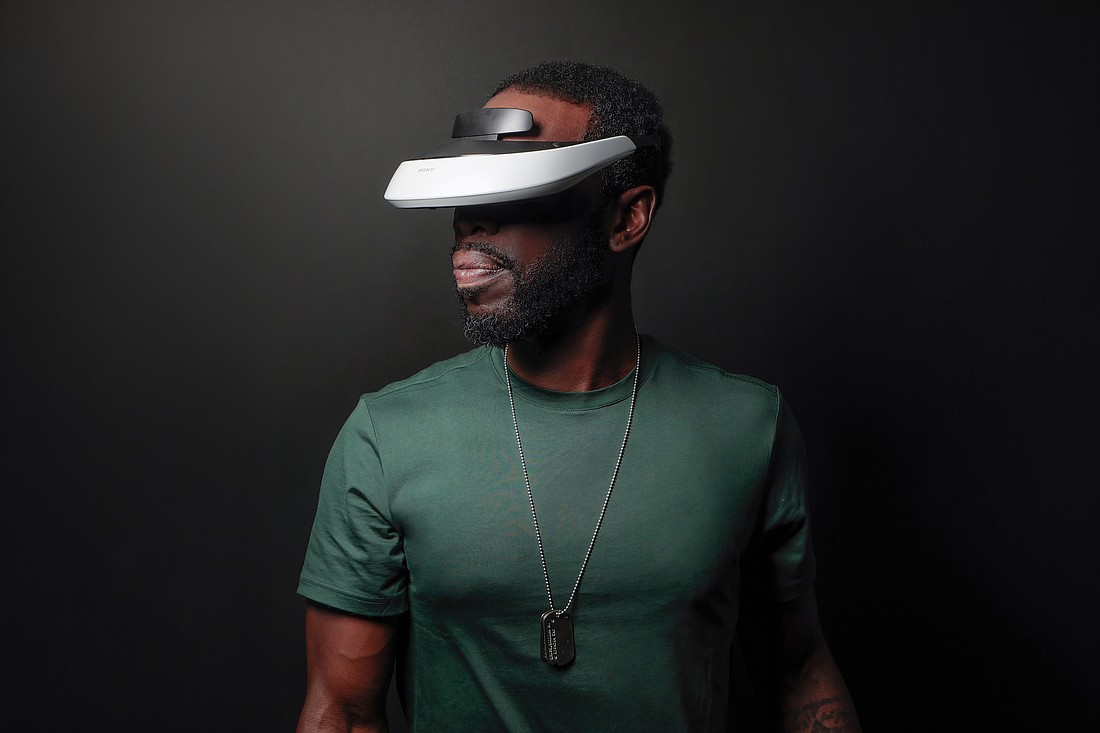- November 19, 2025
-
-
Loading

Loading

Jacqueline Goldfinger’s “Backwards, Forwards Back” at the Urbanite Theatre explores the human cost of war — and society’s debt to surviving veterans. In her play, that debt is honored with cutting-edge technology. As a sci-fi fanatic, I dig that stuff. But the technology’s not the point. The debt is.
This is a one-man play. The protagonist is unnamed. In Goldfinger’s script, he’s simply “The Soldier” (L. James). He’s a combat veteran who’s come back from Iraq, but not intact. His wounds are deep. But they’re not visible.
The Soldier’s mind has been shattered by PTSD. Combat’s random slaughter has rewired his nervous system. Certain triggers can instantly turn him into a killing machine. Khaki pants. Foreign accents. Loud noises. A firecracker sets him off at a Fourth of July picnic. In a blind rage, the Soldier mashes his nephew’s face to a pulp.
After he gets out of jail, his sister has a non-negotiable demand: The Soldier either gets help — or gets lost. That’s against his tough-guy, military code, but he has no choice. So he goes to the VA center and asks for help. The treatment they give him is virtual reality (VR) immersion therapy. (It’s a real thing, not the playwright’s invention.)
In principle, it works like building a tolerance for poison. You start with tiny doses, than slowly increase them. In VR therapy, the “poison” is any stimuli that trigger a fight-or-flight response. The Soldier puts on VR goggles. They fill his eyes with an animated 3-D video based on his life experiences. It’s his own private movie! But it’s not entertaining.
The Soldier’s VR goggles play wartime scenes of fire, explosion and death. These recreate actual traumas from his tour of duty. But he never knows when he’ll see them. This horror show is unpredictable.
Most of the time, nothing’s happening. Just boring desert sands. Or peaceful home-front vistas. Then — without warning — a jump-cut to ultraviolence. The terror comes in small doses at first, then increases. The Soldier slowly builds a tolerance. You can tell he’s getting it together.
You can see The Soldier’s private VR movie, thanks to a huge video monitor. The movie’s 3-D animation is on the level of Doom 95. It’s clunky and kludgy — and obviously unreal. Intellectually, the Soldier knows that. But his amygdala can’t tell the difference. He responds to the triggering stimuli anyway.
When it comes to VR tech, Goldfinger’s play is right on. But VR therapy is just a delivery system. Her play would still work if you substituted hypnosis or Freudian analysis. That said, VR therapy makes for a clever narrative springboard.
The VR movie triggers The Soldier’s panic response. But it also triggers the stories he shares.
Wartime tales of fear and loathing: An IED blows his friend to pieces. A vengeful child aims an AK-47 at his face.
Peacetime memories of days of rage: A viciously brutal bar fight. The Soldier’s psychotic episode on Independence Day.
It’s powerful stuff, but Goldfinger’s not trying to push your buttons. “Backwards Forwards Back” isn’t a manipulative emotional roller coaster. It’s a glimpse into one veteran’s psychic reality.
Director Brendan Ragan takes an egoless approach. Nothing mannered. Nothing gimmicky. He gets out of the story’s way and lets the actor do his job. With a script this good and an actor this talented, that’s wise.
James delivers an X-Ray of The Soldier’s heart, mind and soul. He makes the character feel real — and he’s uniquely qualified to do so. He’s drawing on sense memory, not second-hand accounts. James is a real-world combat veteran. He’s been there.
Jeffrey Weber’s set is perfectly symmetrical. It’s coldly futuristic and antiseptic, like something you’d see in a Stanley Kubrick movie. Center stage, there’s a scooped plastic chair, with a giant video monitor right behind it. (That screen is shaped like VR goggles. Clever touch.)
You can see The Soldier’s private movie, thanks to Alex Pinchin’s projections on that screen. (The pixelated quality is a choice. Hyper-realistic 3-D animation would look like a war movie filmed with live actors. The mid-1990s first-person-shooter look instantly telegraphs that it’s animated.) Lyndell McDonald’s lighting makes a sharp distinction between virtual-reality and reality-reality.
Goldfinger’s dialog is razor-sharp; her storytelling is laser-focused. Every word counts here. A lesser writer would take two hours to tell this tale. She does it in one act. Her economy is worthy of C.M. Kornbluth or Damon Knight. (Read their short stories. Thank me later.)
The Soldier stands for countless other wounded warriors. But he’s not a generic symbol. “Backwards” isn’t an allegory. And The Soldier isn’t Everyman. He’s a unique individual — with specific hope and dreams. Every warrior is. That’s bloody obvious, but people forget. Goldfinger’s character study makes you remember.
“Backwards Forwards Back” reminds you that warriors are people.
Soldiers, marines, airmen, sailors …
Whatever the branch of military service, they’re all human beings.
If you’re going to send them to war, you’d better have a damn good reason.
When some of these warriors return, you’d better not forget them.
Saluting and saying, “Thank you for your service,” just doesn’t cut it.